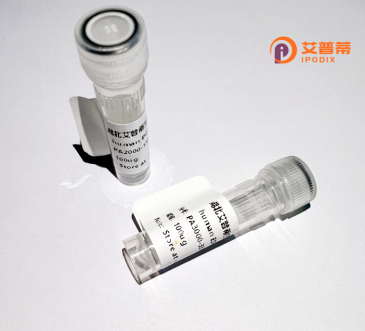
| 纯度 | >90%SDS-PAGE. |
| 种属 | Human |
| 靶点 | ZC3H14 |
| Uniprot No | Q6PJT7 |
| 内毒素 | < 0.01EU/μg |
| 表达宿主 | E.coli |
| 表达区间 | 1-306 aa |
| 活性数据 | MRMSSKFPSPPLPIFLPPEPVDLGSITSSSCSLNELDNISHLLRKISADINEIKGMKAAILTVEANLFDLNVRVSKNEAKISSLEVKMNEYSTTYECNRQFEDQEEDTESQSRTTDVKIIGFLRNVEKGTQQRQLLSRLQIDPVMAETLQMSQAEMSELSVAQKPEKLLERCKYWPACKNGDECAYHHPISPCKAFPNCKFAEKCLFVHPNCKYDAKCTKPDCPFTHVSRRIPVLSPKPVAPPAPPSSSQLCRYFPACKKMECPFYHPKHCRFNTQCTRPDCTFYHPTINVPPRHALKWIRPQTSE |
| 分子量 | 61.3 kDa |
| 蛋白标签 | GST-tag at N-terminal |
| 缓冲液 | PBS, pH7.4, containing 0.01% SKL, 1mM DTT, 5% Trehalose and Proclin300. |
| 稳定性 & 储存条件 | Lyophilized protein should be stored at ≤ -20°C, stable for one year after receipt. Reconstituted protein solution can be stored at 2-8°C for 2-7 days. Aliquots of reconstituted samples are stable at ≤ -20°C for 3 months. |
| 复溶 | Always centrifuge tubes before opening.Do not mix by vortex or pipetting. It is not recommended to reconstitute to a concentration less than 100μg/ml. Dissolve the lyophilized protein in distilled water. Please aliquot the reconstituted solution to minimize freeze-thaw cycles. |
以下是关于重组人ZC3H14蛋白的3篇代表性文献概览:
1. **文献名称**:*ZC3H14 is an mRNA export factor that prevents the nuclear retention of neural transcripts*
**作者**:Kelly et al. (2015)
**摘要**:揭示了ZC3H14蛋白通过结合多聚腺苷酸尾调控mRNA核质转运,重组ZC3H14蛋白实验显示其锌指结构域对维持神经元mRNA稳态至关重要。
2. **文献名称**:*Structural analysis of the zinc finger domains in ZC3H14 reveals RNA-binding specificity*
**作者**:Chen et al. (2018)
**摘要**:通过重组ZC3H14蛋白结构解析,证明其串联CCCH型锌指结构域选择性结合富含腺嘌呤的RNA序列,为研究转录后调控机制提供结构基础。
3. **文献名称**:*ZC3H14 mutations linked to intellectual disability disrupt mRNA export and neural development*
**作者**:Robinson et al. (2020)
**摘要**:利用重组突变体ZC3H14蛋白,发现其功能缺失导致神经元发育异常,验证了遗传突变通过干扰mRNA出核引起智力障碍的分子机制。
---
**补充说明**:
- ZC3H14的研究多聚焦于其RNA结合特性及对神经系统的调控,重组蛋白常被用于功能验证和互作研究。
- 近期文献开始关注其在癌症(如胶质瘤)中的异常表达及剪接调控功能。
- 建议使用PubMed/Google Scholar以“ZC3H14 AND (recombinant OR structure)”为关键词获取最新研究。
The human ZC3H14 protein, encoded by the ZC3H14 gene, is a ubiquitously expressed zinc finger-containing protein implicated in RNA metabolism and post-transcriptional regulation. Structurally, it contains a conserved CCCH-type zinc finger domain critical for RNA binding, a nuclear localization signal, and a nucleolar localization sequence. ZC3H14 predominantly localizes to the nucleus and nucleolus, where it interacts with components of the mRNA processing machinery, including the spliceosome, and regulates mRNA polyadenylation, stability, and nuclear export. Studies link ZC3H14 dysfunction to neurological disorders such as intellectual disability and amyotrophic lateral sclerosis (ALS), underscoring its importance in neuronal development and maintenance.
Recombinant human ZC3H14 protein, produced via heterologous expression systems (e.g., E. coli, mammalian cells), enables detailed biochemical and functional studies. Purified ZC3H14 retains RNA-binding activity and facilitates investigations into its interaction partners, structural properties, and regulatory mechanisms. Its recombinant form is instrumental in screening for modulators of RNA-binding activity and potential therapeutics for ZC3H14-related disorders. Research on recombinant ZC3H14 also sheds light on its role in alternative polyadenylation, a process critical for transcript diversity, and its crosstalk with other RNA-binding proteins. As a molecular tool, it advances understanding of RNA biology and disease pathogenesis linked to post-transcriptional dysregulation.
×